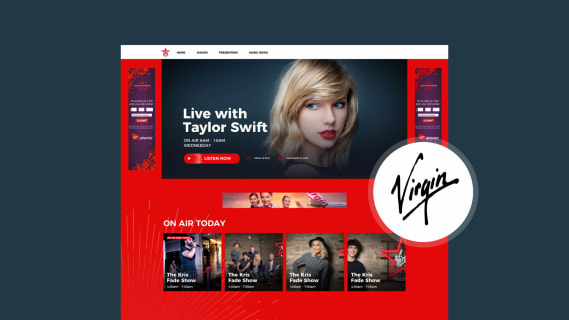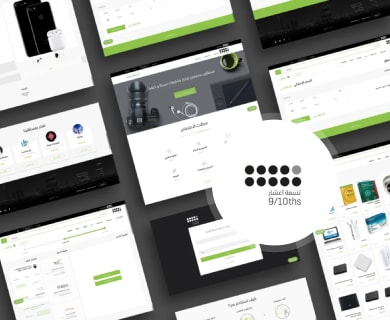MVP development - everything you want to know, but are afraid to ask
So, you have a plan for a perfect MVP app, web service or new business line? Everything is defined and the backlog is full of amazing features that your users will surely love. You just need to develop it (with an in-house dev team or an external one) and wait for the well deserved applause. What could possibly go wrong?
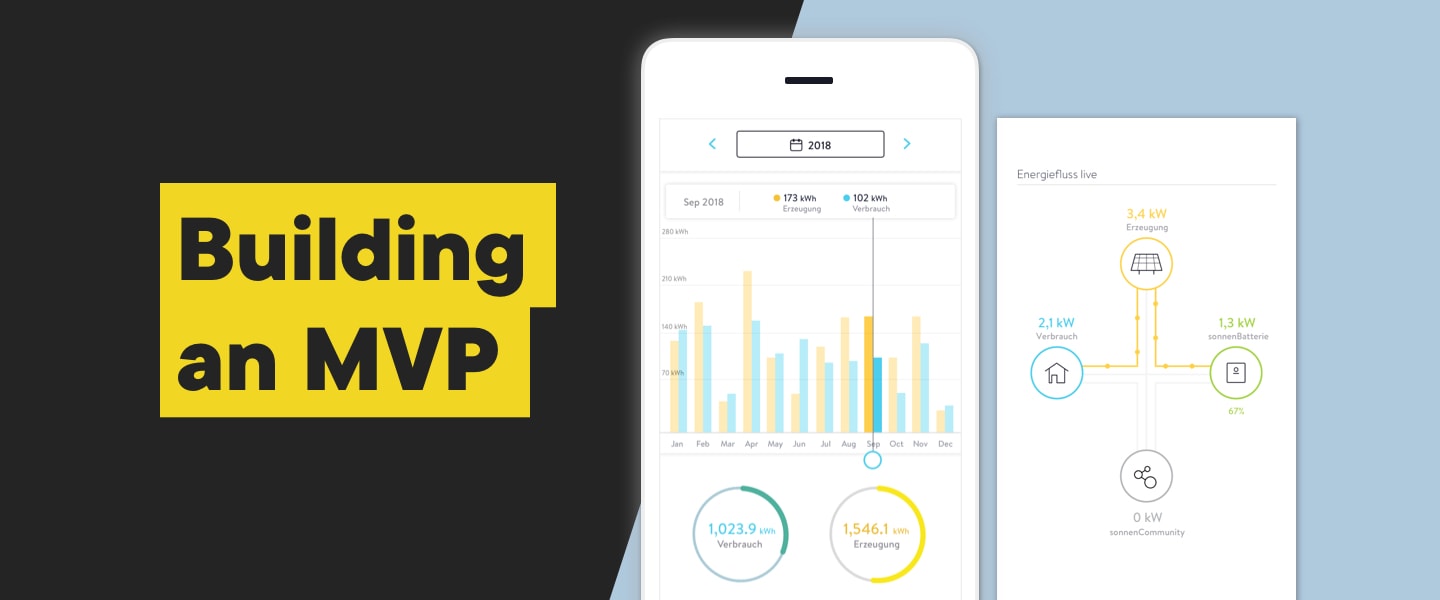
Table of contents
Well, literally everything.
The perfect features you gathered could be uninteresting to target users, the backlog might be overloaded with (otherwise great!) “essential” features and the budget that you proposed means your CFO will be avoiding you.
While your digital product idea may be potentially successful, the strategy and its execution is crucial. If you are going to:
- start new business with an app,
- diversify your revenue stream with a new product or service,
- transfer your offline business to online,
- test your business idea,
then you should consider using an MVP (Minimum Viable Product). And this leads us to one, amazingly important question.
What is an MVP development and what isn’t it?
The idea of the MVP has been around in the business world for a while and it is inseparably linked with lean startup methodology. Before we jump into the details, let’s focus on a practical definition of a Minimum Viable Product to help us to understand what’s really important here.
What are the characteristics of an MVP app or website?
Minimum - this means that an ideal MVP app should include only a few, core and absolutely vital features. What does that mean in practice?
Let’s imagine a web app, let’s call it “Director’s Cut”, that allows movie fans to create accounts and share their recommendations about films with other cinephiles. What would be the minimum features that would allow users to enjoy this web service?
From a business point of view, a straightforward method of creating personal user accounts is a very basic minimum. It helps to gather data about users, keeps them close to the app and is essential for marketing campaigns. Every user should be able to create an account quickly, with minimum effort, adding his or her personal info such as a profile picture, nickname, favorite movie genre and even their recommendations for new movies. This is, arguably, the minimum.
Features such as adding video avatars, graphic badges, recording videos, and using movie-themed filters and stickers is beyond a common sense definition of “minimum”.
This takes into consideration the economic side of the development process - every new feature added to the scope of your MVP means more money spent and more time in development.
Viable means capable of functioning. Our cinematic app should have a properly functioning back-end, nicely looking and a user-friendly UX, and should work without crashing every time someone tries to write a review of the new X-Men movie.
The ‘P’ in MVP stands for Product and this needs no explanation.
See more in the article: What is MVP development.
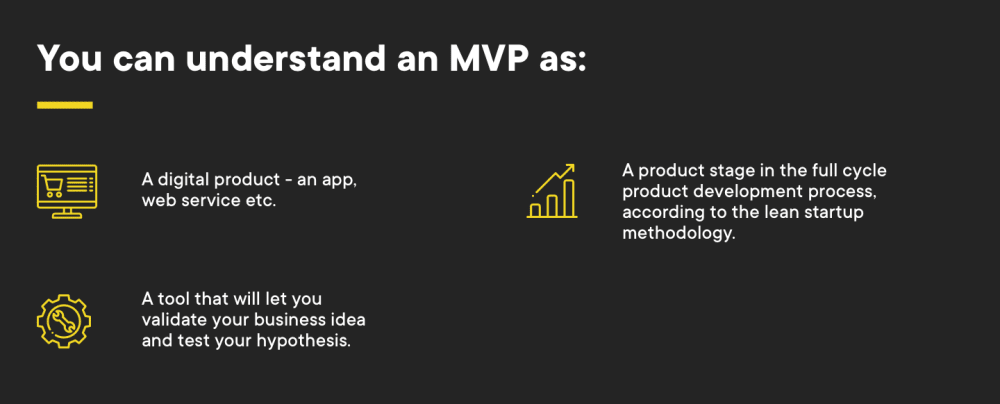
An MVP is a tool that provides a minimum of features but makes the app usable and fully functioning.
Our “Director’s cut” app, with a few additional indispensable features I didn’t mention (YouTube support!) is surely an MVP. Users should be able to download it, create an account and engage in discussion with other users.
Long story short: to create an MVP means to launch an app that addresses real user needs, and it’s developed in a very short time.
Check out more here: How to build a minimum viable product
What is not an MVP?
As we have already defined what an MVP is, let’s look at when a digital product is not an MVP and debunk some of the most popular misunderstandings.
An MVP is not a prototype
An MVP is a working piece of software that should and can be used by real users. A prototype (read more about digitatal prototypes here) on the other hand, is usually a graphic representation of a future product that can be tested by potential users or investors to represent a very general idea. It can be clickable, but has no working functionalities and can’t be released to the market.
What’s more, MVPs and prototypes are two separate stages of business product development, according to the lean startup methodology. The full process includes:
- Prototyping
- Minimum viable product (MVP)
- Product-market fit
- Scaling
If you’re interested in knowing more about prototyping, read our article on How prototyping can bring your business ideas to life.
An MVP doesn’t mean cutting corners
If you’re thinking of producing a great product but you want to save costs by dropping viable functionalities and making it quicker than is really possible, then it’s not a real MVP. It’s just an app that is made … badly. Why is it a bad idea to release such product?
- Users will not appreciate an unfinished or buggy app.
- Most likely, your hypothesis will not be viable.
- Your potential customers will be scared off.
- You may expose your brand to a crisis of reputation.
An MVP is not a final version of the app
Yes, the ideal MVP development should include the most important features to enable users to interact with it. Nonetheless, it doesn’t matter that the development process will only be finished after releasing the app to the market. This is just the beginning, and you should already be thinking about an actionable roadmap based on customer feedback and data collected from actual users.
An MVP is not for startups only
Many people, including those working in the IT industry, associate MVPs with startups only. While new businesses can benefit from using an MVP to enter the market or pitch investors, it’s not a tool reserved only for them. MVPs can be profitable for companies of different maturity levels and different industries.
Now we know what an MVP is (and isn’t), let’s move forward to see what’s most important when building an MVP.
The real purpose of an MVP - testing and validating
It’s simple, an MVP helps you to validate your business idea. To make use of this tool, you need to define your business hypothesis first. And do so before beginning to build the actual app. Our fictional hypothesis for “Director’s Cut” app will be:
The number of active users is growing and traction is steady. Taking into account the current growth rate, and the CPM (‘cost per mile’) price for displaying ads in the app, “Director’s Cut” will be profitable within 6 months from launch.
With this approach, you should probably take into account such metrics as:
- Number of new accounts,
- Number of active users,
- Growth rate
- User engagement rates and traffic
- ROI
Why are those data and metrics so important?
Because one of the most common mistakes decision makers are making is assuming that they know “for sure” how such a product should work and what kind of results it will bring. Sometimes their guess is right (that’s great!), but most likely, it’s not.
Without validating and testing, it’s impossible to make valuable, data-driven decisions. This is why one of the ideas that stands behind MVPs as a tool is “validate, don’t guess”.
Just to sum things up, what would the perfect, ideal outcome of MVP development?
- Having a working app or service.
- Validating your business idea and learning if it makes sense to make your product the way you planned.
- A steadily growing number of active users.
- Time to market ratio is minimized.
- Valuable feedback coming from users, that can be easily mapped in the backlog as future functions.
- A clearly visible and defined roadmap for product development and scaling.
All of this can be concluded in one very simple and smart sentence I found in this article written by Lukas Gisder-Dubé:
Time spent not on the market equals time wasted.
Simple as can be!
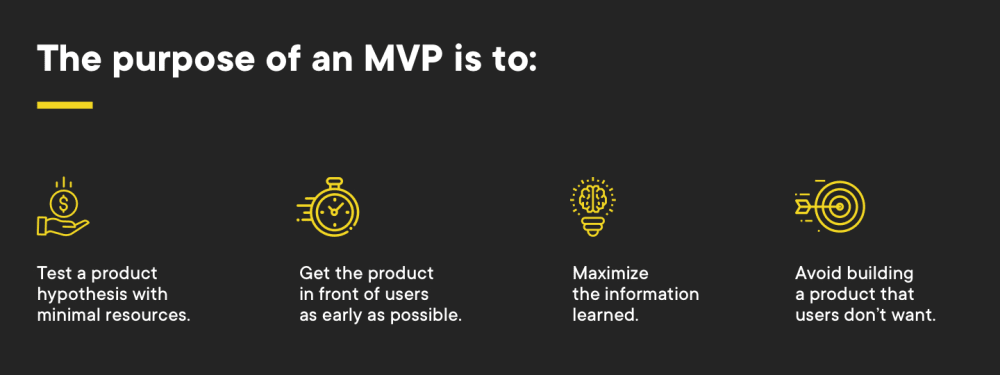
MVP cost - the resources and costs perspective
If your organization has an in-house design and development team that is capable of making an MVP, then calculating the budget is quite easy.
What if you, regardless of the reasons, prefer to work with an external software development partner?
In the software development industry, many things are relative. For example, the cost of app development varies because it depends on multiple factors. However, an MVP is supposed to be quick to design and develop and this approach is influenced by two main indicators: time and human resources. To give you an idea on what you should expect when it comes to the whole development process, take a look at the data from our, Boldare’s, perspective.
The “average” MVP app or web means:
- A dedicated team made of up to 3 or 4 members, including product designers, developers and usually a scrum master that helps to organize work and maintain focus.
- The price for the whole service (consulting, design, development etc.) somewhere between $30k and $60k. Note that this factor strongly depends on the scope of works.
- 6 to 8 weeks before the app hits the market.
- Both teams working in scrum and agile frameworks.
- Working code delivered within 1-2 weeks and new features added incrementally.
- In most cases, we organize workshops that allow both teams (the client’s and ours) to meet, learn about each other and very clearly understand the business goals and product details.
- Taking into account the different needs of our partners, we always offer two, slightly different and tailor-made proposals that vary in proposed solutions and price.
I hope that gives a better idea of what you could potentially expect from us.
MVP - the good practices and pro tips
If you decide to work with an external development company, most likely the assigned team will consist of a developer, a product designer and a scrum master (in the case of working with Boldare, it will). To give you better insight into what is important in the MVP development process, we asked our employees with experience in such projects to share their pro tips with you.
“Flexibility is the key”, says Damian Kozar, one of Boldare’s software developers.
Remember that it’s all about validation of a real business need, not about full implementation of an initial idea. Multiple changes and pivots happens on a daily basis and the technology stack has to be prepared for that. From the developer’s perspective, when working on an MVP, it’s very important to choose tools that will enable agile and quick implementation of most basic functionalities, but also the flexibility to change and add features in the near future. The perfect set-up for an MVP should allow the release of a working piece of code very quickly. In the case of a strategic decision to switch to different technology, the app should be easy to recreate in the new environment. On the other hand, the technology stack should include a lot of space to grow - after finishing the MVP stage, the product has to be developed further.
Paweł Capaja, a Boldare product designer with over 11 years of experience, suggested three personal pro tips to product owners working on an MVP.:
One of the best ways to kick off the development process, is by conducting User Story Mapping workshops. These are a great way to set the goals and scope of the whole development process. It’s extremely important for both sides, to “be on the same page” and understand one another’s needs perfectly. Another super important thing to pay attention to is having a detailed, but realistic roadmap, so that every single team member knows the timeframe and when each functionality should be delivered. Time is money! Regular and frequent reviews of work progress are indispensable, and one of the ways to make sure they happen is working in a scrum methodology. An experienced scrum team needs minimum supervision and knows how to deliver iterations.
Iwona Franke is a Boldare scrum master mostly focused on MVPs. I asked her about the most important thing when working on MVPs from her point of view, and about what product owners (working on behalf of our partners) should pay special attention to.
I think that the two-sided workshops at which we start work on an MVP are crucial. It’s because we want to be sure that the entire team understands the purpose of the MVP we want to build and workshops are the best way to set clear goals and understand each other’s expectations. During the development process, we are regularly checking if we’re still on track and if we are still going in the direction set at the beginning, which helps us validate the hypothesis we set during those initial talks” - said Iwona.
What about the product owner representing our partners?
It’s important to bear in mind that the MVP we are working on is a test. We are validating a hypothesis and this means that at the end of the day, it’s possible that we will have to change the app extensively and discard most of the features. Knowing that should help with setting the goals and priorities for the whole team. So, if you - as a product owner - have the chance to work on an MVP, you need to ask yourself: is this particular part of the app really essential to test the idea or the product or not? This kind of approach can save a lot of time!”
I hope you find this insights useful!
MVP teams
As already mentioned above, a team working on an MVP should understand its purpose, and should also have previous experience with this type of product. When we create an MVP team for our partners, we select experts who have not only worked on numerous MVP releases, but also meet the following conditions:
- are able to resist including even the most interesting features, if they don’t fit the MVP concept of delivering only the most crucial functionalities
- are strong in problem solving, not only on a technical level
- practice excellent communication, staying in constant touch with the product’s stakeholders
And most importantly: they know how to balance MVP best practices, product quality and business goals.
What comes after an MVP development?
Releasing a minimum viable product to a market is just the beginning! Next you have to focus on testing, validating and studying: does your MVP fulfil your hypothesis, or maybe it still lacks something?
Some of the many potential paths after releasing an MVP are:
- Testing and gathering data to check if the hypothesis was validated or not.
- Adding or removing features according to the gathered information.
- Working on a brand new version of the app.
- Moving forward to the next product stage, product-market-fit which means working on new features and platforms.
At Boldare, we work closely with our partners to map out next steps based on the information we gather during MVP stage. We help with carrying out tests and choosing the right tools, and offer support from our business analysts.
After a successful validation, the perfect scenario “after the MVP” would be to enlarge the team, create a backlog and embark on a new adventure!
MVP development - a tool to leverage your business
As mentioned at the beginning, an MVP has a lot to offer organizations that want to work with new business ideas, apps or services. An MVP is based on the agile approach and thus has a broad range of use cases. If you build and use it properly, an MVP can carry a lot of benefits for your current and future products.
Share this article:




